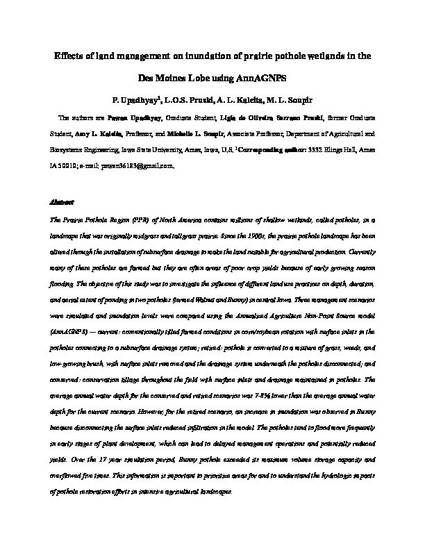
The Prairie Pothole Region (PPR) of North America contains millions of shallow wetlands, called potholes, in a landscape that was originally midgrass and tallgrass prairie. Since the 1900s, the prairie pothole landscape has been altered through the installation of subsurface drainage to make the land suitable for agricultural production. Currently, many of these potholes are farmed but they are often areas of poor crop yields because of early growing season flooding. The objective of this study was to investigate the influence of different land use practices on depth, duration, and aerial extent of ponding in two potholes (termed Walnut and Bunny) in central Iowa. Three management scenarios were simulated and inundation levels were compared using the Annualized Agriculture Non-Point Source model (AnnAGNPS) — current: conventionally tilled farmed conditions in corn/soybean rotation with surface inlets in the potholes connecting to a subsurface drainage system; retired: pothole is converted to a mixture of grass, weeds, and low-growing brush, with surface inlets removed and the drainage system underneath the potholes disconnected; and conserved: conservation tillage throughout the field with surface inlets and drainage maintained in potholes. The average annual water depth for the conserved and retired scenarios was 7–8% lower than the average annual water depth for the current scenario. However, for the retired scenario, an increase in inundation was observed in Bunny because disconnecting the surface inlets reduced infiltration in the model. The potholes tend to flood more frequently in the early stages of plant development, which can lead to delayed management operations and potentially reduced yields. Over the 17 year simulation period, Bunny pothole exceeded its maximum volume storage capacity and overflowed five times. This information is important to prioritize areas for and to understand the hydrologic impacts of pothole restoration efforts in intensive agricultural landscapes.
Available at: http://works.bepress.com/michelle_soupir/97/

This is a manuscript of an article published as Upadhyay, P., L.O.S. Pruski, A. L. Kaleita, and M. L. Soupir. "Effects of land management on inundation of prairie pothole wetlands in the Des Moines Lobe using AnnAGNPS." Agricultural Water Management 213 (2019): 947-956. DOI: 10.1016/j.agwat.2018.12.016. Posted with permission.